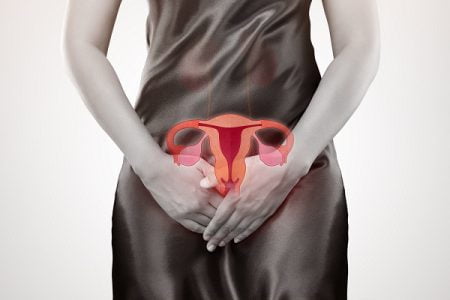How Do You Get Cervical Cancer?
- Updated on: Jul 15, 2024
- 4 min Read
- Published on Nov 12, 2020

Cancers occur due to DNA mutations or gene defects. Mutations or gene defects somehow turn on the oncogenes or turn off the tumor suppressor genes. Cervical cancer occurs due to precancerous cells in the cervix. Any abnormal growth in the cervix may result in tumor formation, which then turns into cancerous lesions. The chances of getting cervical cancer are increased in people who indulge in sexual practices at an early age, use excessive birth control pills, have multiple sexual partners, people with a weak immune system, improper diagnosis, etc.
In the case of cervical cancer, questions often arise: how do women get cervical cancer, reasons for cervical cancer, etc. These queries are best solved when the root cause behind the occurrence of cervical cancer is found.
How Do Women Get Cervical Cancer?
Human papillomavirus (HPV) refers to a group of viruses (rather than a single virus) and is efficient enough to cause a sexually transmitted viral infection.
HPV affects about 75% of sexually active women. Human papillomaviruses lead to the production of two proteins- E6 and E7. These two proteins turn off some tumor suppressor genes, which results in the development of tumors. Due to excessive production of E6 and E7 proteins, cells in the cervical lining grow in abundance and lead to the development of changes in additional genes, which, in a few cases, cause cervical cancer. There are many ways to get HPV, but the most known reason for cervical cancer is sexual contact between two people.
Although HPV infection is very common, it is not necessary that it may result in the development of any cancer. Sometimes, HPV infections result in benign warts on the skin or genital organs, which can be treated easily and are supposed to be “low risk” HPV. “High risk” HPV has greater chances of causing cancers of the cervix as well as cancers of the penis in men. Infection by HPV can also lead to cancers of the mouth, throat, and anus in both men and women. Sometimes, mild HPV infection causes cervical dysplasia or abnormal growth of cervical cells.
It has been found that HPV is not the single cause of cervical cancer. There can be several other reasons for cervical cancer, such as smoking and HIV infection, excessive use of hormonal drugs, etc.
Read About Human Papillomavirus (HPV) Vaccination for Prevention of Cervical Cancer in Women
Can Men Get Cervical Cancer: HPV in Men?
HPV virus (human papillomavirus) infection is more prominent in women; however, it can cause health problems in men, too. HPV infection elevates the risk of getting genital cancers in men, but this happens rarely. Sometimes, HPV infection can also cause genital warts in men and, rarely, can also lead to anus or penis cancers.
HPV infection in men occurs in the same way as in women, i.e., through direct or intimate contact (sexual contact).HPV infection spreads from one person to another through oral, anal, or vaginal sex, or only through intimate skin-to-skin contact.
Dysplasia (or Cellular Changes)
Dysplasia is when some abnormal cells start appearing themselves. These cells might not be cancerous but can be precancerous. Sometimes, the cervix’s dysplasia leads to cervical cancer identification during Pap testing and is referred to as a squamous intraepithelial lesion (SIL). If the abnormal growth is not stopped, it can lead to tumor development in the cervix, leading to cancer.
Cervical Intraepithelial Neoplasia (CIN)
Cervical intraepithelial neoplasia (CIN) is another class of precancerous changes in the cervix. These changes are observed on the infected tissue samples (such as during biopsies). Precancerous changes in the cervix can be treated in most cases, which prevent the development of cervical cancer. Another class of similar abnormal changes is cervical glandular intraepithelial neoplasia (CGIN). Precancerous conditions do not immediately pose any danger to the infected person’s health, but there are strong chances for them to develop into cancer when left untreated.
Factors That Increase the Risk of Getting Cervical Cancer: How Can a Woman Get HPV?
Women with weak immune systems have strong and higher chances of catching infections (due to HPV), leading to the development of precancerous tumors.
Regular smoking habits increase the chances of developing cervical cancer. This is supposedly due to the harmful effects of agents or chemicals (found in tobacco) on the cervix’s cells. These drugs suppress the function of the immune system by lowering the autoimmune response.
Excess consumption of a hormonal drug “diethylstilbestrol (DES)” during pregnancy might affect the child and, sometimes, the mother. In the mid-90s, the use of diethylstilbestrol (DES) was very prominent to prevent miscarriage, but this became another reason that led to cervical cancer in women.
Another bacterium that commonly infects the reproductive system is Chlamydia. Chlamydia, in general, spreads during sexual contact. Infection due to Chlamydia can lead to chronic pelvic inflammation, leading to infertility in most cases.
Read About Early Detection, Prevention, and Screening of Cervical Cancer
How to Detect Cervical Cancer?
Diagnosis of cervical cancer during the early stages is made with the help of different screening techniques. The screening guidelines for cervical cancer state that a Pap smear combined with an HPV test should be conducted every three to five years for women aged 30 and above. Pap testing is supposed to be the best way to detect any abnormal changes in the cervix (before cancer develops).
Regular pelvic exams can also help in diagnosing precancerous changes in the cervix. Colposcopy and cervical biopsies are conducted to detect precancerous changes.
Although there is no proper cure for HPV infection, certain treatments have shown effectiveness in treating genital warts and precancerous cervical lesions due to HPV. Some vaccines are not efficient enough to cure cervical infections, but they might prevent it in the first place. The precancerous changes in the cervix can then be treated with cryosurgery, cauterization, or laser surgery to avoid cancer development.
Check Out Our Trusted Resources on Cervical Cancer












